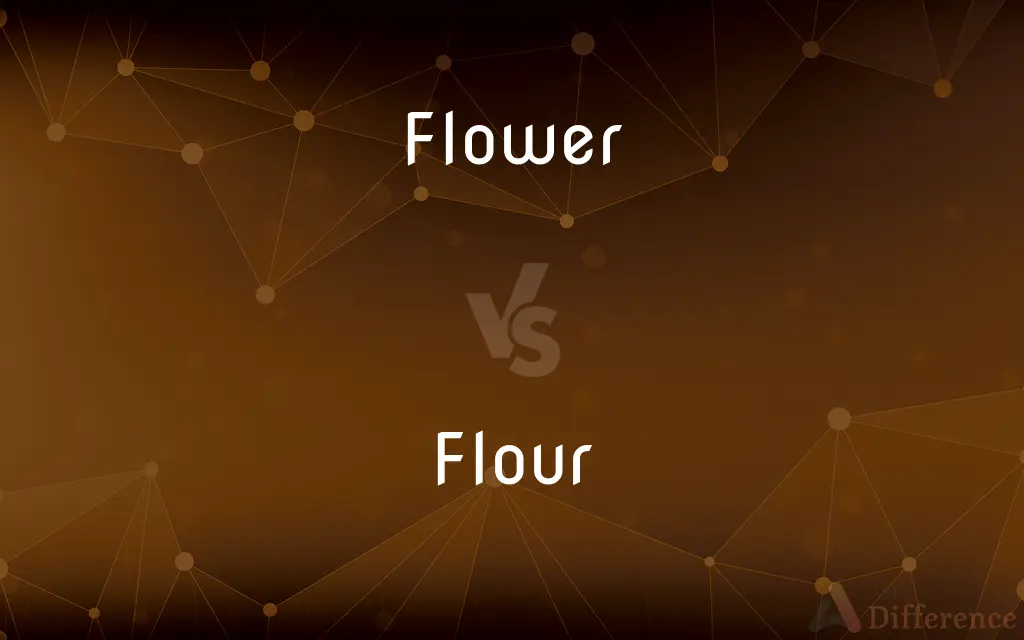Flower vs. Flour — What's the Difference?
By Fiza Rafique & Urooj Arif — Updated on April 23, 2024
Flower refers to the reproductive part of a plant, typically colorful and fragrant, while flour is a fine powder obtained by grinding grains, nuts, or seeds.

Difference Between Flower and Flour
Table of Contents
ADVERTISEMENT
Key Differences
Flowers are the reproductive structures in flowering plants, known for their varied colors and forms which attract pollinators. Flour, on the other hand, is the product of milling and grinding cereal grains, primarily wheat, used extensively in baking.
Flowers play a crucial role in ecosystems, facilitating pollination and producing seeds for new plants. Whereas flour serves as a fundamental ingredient in many food products, from bread to pastries, pivotal in human diets.
Flowers exhibit natural beauty and are used decoratively and symbolically in various cultures. Flour, however, is valued for its utility in cooking and baking, forming an essential component of numerous recipes.
Flowers can be grown in gardens, wild areas, or cultivated on a commercial scale for sale. Flour is produced through an industrial process that includes milling, which involves refining grains to achieve the desired consistency.
The use and significance of flowers are often associated with occasions such as weddings, funerals, and celebrations, symbolizing emotions like love, grief, and joy. Flour is economically significant, influencing food industries globally and is a staple in everyday cooking and baking.
ADVERTISEMENT
Comparison Chart
Definition
The reproductive structure of a plant.
A fine powder made from ground grains.
Primary Use
Decoration, symbolism, and natural beauty.
Cooking and baking staple.
Cultural Significance
Symbolic in various ceremonies and traditions.
Essential in many cultural cuisines.
Production Process
Grown in gardens or farms.
Produced by milling grains.
Varieties
Numerous species like roses, lilies, daisies.
Various types like wheat, almond, and coconut.
Compare with Definitions
Flower
Pollen.
Bees collect pollen from flowers to feed their colonies.
Flour
Gluten.
Flour's gluten content is crucial for the elasticity of dough.
Flower
Bud.
The garden was full of buds, promising a colorful display.
Flour
Bleached.
Bleached flour is chemically treated to appear whiter and finer.
Flower
Blossom.
The cherry trees blossom in early spring, signaling warmer weather.
Flour
Self-rising.
Self-rising flour includes baking powder and salt, making baking easier.
Flower
Perennial.
Many gardeners prefer perennials for their long-lasting blooms.
Flour
Whole-wheat.
Whole-wheat flour adds a nutty flavor and hearty texture to bread.
Flower
Petal.
The petals of the rose were soft and fragrant.
Flour
Starch.
Flour is often used to thicken sauces due to its starch content.
Flower
A flower, sometimes known as a bloom or blossom, is the reproductive structure found in flowering plants (plants of the division Magnoliophyta, also called angiosperms). The biological function of a flower is to facilitate reproduction, usually by providing a mechanism for the union of sperm with eggs.
Flour
Flour is a powder made by grinding raw grains, roots, beans, nuts, or seeds. Flours are used to make many different foods.
Flower
The reproductive structure of angiosperms, characteristically having either specialized male or female organs or both male and female organs, such as stamens and a pistil, enclosed in an outer envelope of petals and sepals.
Flour
A powder obtained by grinding grain, typically wheat, and used to make bread, cakes, and pastry.
Flower
Such a structure having showy or colorful parts; a blossom.
Flour
Sprinkle (something, especially a work surface or cooking utensil) with a thin layer of flour.
Flower
A flower head.
Flour
Grind (grain) into flour.
Flower
A plant that is cultivated or appreciated for its blossoms.
Flour
A fine, powdery foodstuff obtained by grinding and sifting the meal of a grain, especially wheat, used chiefly in baking.
Flower
The condition or a time of having developed flowers
The azaleas were in full flower.
Flour
Any of various similar finely ground or powdered foodstuffs, as of cassava, chickpeas, or bananas.
Flower
The period of highest development or greatest vigor. ]
Flour
A soft, fine powder.
Flower
(botany) A reproductive structure in angiosperms (flowering plants), often conspicuously colourful and typically including sepals, petals, and either or both stamens and/or a pistil.
Flour
To cover or coat with flour.
Flower
A plant that bears flowers, especially a plant that is small and lacks wood.
We transplanted the flowers to a larger pot.
Flour
To make into flour.
Flower
A cut flower; the stem of a flowering plant with the blossom or blossoms attached, used for decoration, as a gift, etc.
He always keeps a vase full of flowers in his office.
Flour
Powder obtained by grinding or milling cereal grains, especially wheat, or other foodstuffs such as soybeans and potatoes, and used to bake bread, cakes, and pastry.
Flower
(usually with in) Of plants, a state of bearing blooms.
The dogwoods are in flower this week.
Flour
The food made by grinding and bolting cleaned wheat (not durum or red durum) until it meets specified levels of fineness, dryness, and freedom from bran and germ, also containing any of certain enzymes, ascorbic acid, and certain bleaching agents.
Flower
The vulva, especially the labia majora.
Flour
Powder of other material.
Wood flour, produced by sanding wood
Mustard flour
Flower
The best examples or representatives of a group.
Flour
Obsolete form of flower
Flower
The best state of things; the prime.
She was in the flower of her life.
Flour
(transitive) To apply flour to something; to cover with flour.
Flower
(obsolete) Flour.
Flour
(transitive) To reduce to flour.
Flower
A substance in the form of a powder, especially when condensed from sublimation.
The flowers of sulphur
Flour
(intransitive) To break up into fine globules of mercury in the amalgamation process.
Flower
A figure of speech; an ornament of style.
Flour
The finely ground meal of wheat, or of any other grain; especially, the finer part of meal separated by bolting; hence, the fine and soft powder of any substance; as, flour of emery; flour of mustard.
Flower
(printing) Ornamental type used chiefly for borders around pages, cards, etc.
Flour
To grind and bolt; to convert into flour; as, to flour wheat.
Flower
Menstrual discharges.
Flour
To sprinkle with flour.
Flower
A delicate, fragile, or oversensitive person.
Flour
Fine powdery foodstuff obtained by grinding and sifting the meal of a cereal grain
Flower
(rare) Something that flows, such as a river.
Flour
Cover with flour;
Flour fish or meat before frying it
Flower
To put forth blooms.
This plant flowers in June.
Flour
Convert grain into flour
Flower
To decorate with pictures of flowers.
Flower
To reach a state of full development or achievement.
Flower
To froth; to ferment gently, as new beer.
Flower
To come off as flowers by sublimation.
Flower
In the popular sense, the bloom or blossom of a plant; the showy portion, usually of a different color, shape, and texture from the foliage.
Flower
The fairest, freshest, and choicest part of anything; as, the flower of an army, or of a family; the state or time of freshness and bloom; as, the flower of life, that is, youth.
The choice and flower of all things profitable the Psalms do more briefly contain.
The flower of the chivalry of all Spain.
A simple maiden in her flowerIs worth a hundred coats of arms.
Flower
Grain pulverized; meal; flour.
The flowers of grains, mixed with water, will make a sort of glue.
Flower
A substance in the form of a powder, especially when condensed from sublimation; as, the flowers of sulphur.
Flower
A figure of speech; an ornament of style.
Flower
Ornamental type used chiefly for borders around pages, cards, etc.
Flower
Menstrual discharges.
Flower
To blossom; to bloom; to expand the petals, as a plant; to produce flowers; as, this plant flowers in June.
Flower
To come into the finest or fairest condition.
Their lusty and flowering age.
When flowered my youthful spring.
Flower
To froth; to ferment gently, as new beer.
That beer did flower a little.
Flower
To come off as flowers by sublimation.
Observations which have flowered off.
Flower
To embellish with flowers; to adorn with imitated flowers; as, flowered silk.
Flower
A plant cultivated for its blooms or blossoms
Flower
Reproductive organ of angiosperm plants especially one having showy or colorful parts
Flower
The period of greatest prosperity or productivity
Flower
Produce or yield flowers;
The cherry tree bloomed
Common Curiosities
Is flour used in products other than food?
Flour can also be used in non-food products like glue and bioplastics.
What is the difference between white and whole-wheat flour?
White flour is refined and lacks the bran and germ, whereas whole-wheat flour includes all parts of the grain.
How does flour affect people with gluten intolerance?
People with gluten intolerance may experience adverse reactions to wheat flour and should opt for gluten-free alternatives.
What is the shelf life of flour?
Flour's shelf life can vary from 6 months to 1 year, depending on the type and storage conditions.
What are the main types of flowers?
Common types include annuals, perennials, and biennials.
How do flowers reproduce?
Flowers reproduce through pollination, leading to the production of seeds.
Are there any health benefits associated with flowers?
Some flowers are used in traditional medicine and can provide health benefits.
What is the main purpose of flour in baking?
Flour provides structure to baked goods through its gluten content.
What grains are most commonly used to make flour?
Wheat, corn, and rice are the most commonly used grains for flour.
Can flowers be edible?
Yes, some flowers like nasturtiums and violets are edible.
How are flowers used in cultural events?
Flowers are used in various events like weddings and funerals for decoration and symbolic meanings.
What are the environmental impacts of growing flowers?
Commercial flower growing can lead to pesticide use and water consumption.
Can flowers have a role in pollution control?
Certain flowers can absorb pollutants and help in biofiltration.
How is flour made?
Flour is made by grinding grains into a fine powder and sometimes further processing to adjust its properties.
Do all flowers smell pleasant?
Not all flowers have a pleasant scent; some, like the corpse flower, emit a strong, unpleasant odor.
Share Your Discovery

Previous Comparison
Behalf vs. Behave
Next Comparison
Research vs. ProjectAuthor Spotlight
Written by
Fiza RafiqueFiza Rafique is a skilled content writer at AskDifference.com, where she meticulously refines and enhances written pieces. Drawing from her vast editorial expertise, Fiza ensures clarity, accuracy, and precision in every article. Passionate about language, she continually seeks to elevate the quality of content for readers worldwide.
Co-written by
Urooj ArifUrooj is a skilled content writer at Ask Difference, known for her exceptional ability to simplify complex topics into engaging and informative content. With a passion for research and a flair for clear, concise writing, she consistently delivers articles that resonate with our diverse audience.














































